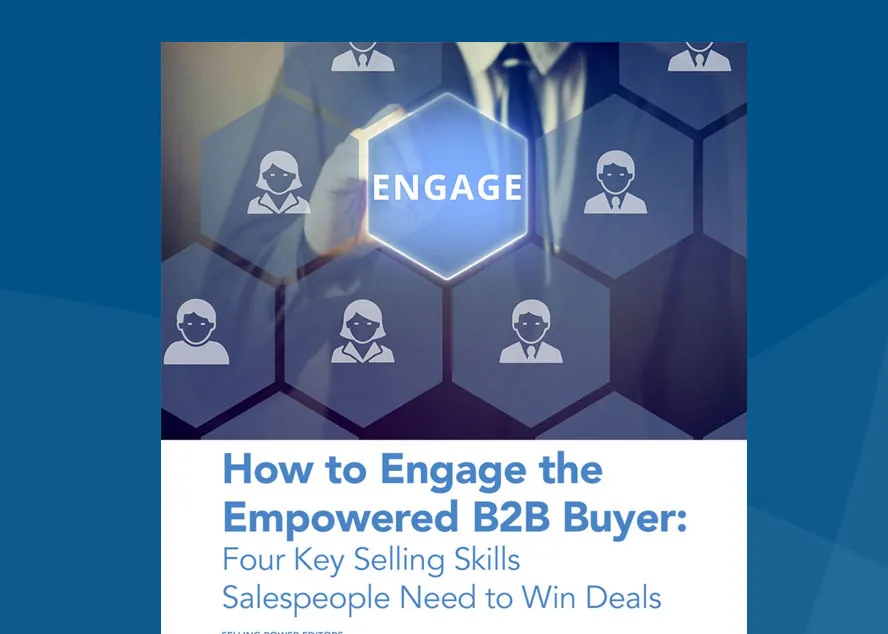The Challenges of Selling to the Informed Customer

It’s no secret that today’s buyers are much better informed than their counterparts just 5 or 10 years ago. Today, information is a mouse click away on the Internet and in fact, a study by Accenture revealed that a staggering 94% of B2B buyers conduct some sort of online research before making a purchase. But with all this information at their fingertips, a new challenge has emerged – for the buyer and the seller.
Most buyers like to think of themselves as empowered and equipped with information, and as a result, don’t engage vendors until after doing some initial research and forming an opinion. At the same time, many of these same buyers find themselves overwhelmed by the wealth of information available and develop a growing uncertainty about making an informed decision. Instead of a feeling of empowerment, “choice paralysis” sets in fueled by confusion and misleading or misinterpreted information.
As a result, we in the B2B realm are often faced with prospects and customers who not only come equipped with hard data and information, but also with preconceived notions and assumptions, traced with a healthy dose of skepticism. As a sales professional, how do you tactfully challenge their way of thinking?
A typical reaction we witness with many B2B sellers is the tendency to want to engage a misinformed customer with more information, more benefits, more features. They run the risk of making an already complex and stressful purchase even more difficult and confusing if the conversation isn’t handled tactfully. Instead, sales professionals should acknowledge and respond to the customer with an empathy statement and direct the conversation towards a strategic discovery process. This could sound something like this:
“I understand you’re looking to purchase widget x and I appreciate that you’ve turned to us as a potential partner. While the internet is a great start to do research, this industry is complex and there are a lot of differing opinions and online advice that may be taken out of context and not be ideal for each situation. Purchasing widget x is an important endeavor, and I want to make sure that our solution provides you with the benefits that your situation calls for. If you don’t mind, let me ask you a few questions to get a better idea of what it is you’re trying to achieve with purchase of widget x.”
Once the strategic discovery process is underway, you can provide insight and politely challenge the customer’s thinking and assumptions based on what was shared with you. Effective sales professionals should be able to provide perspective on the market and help their prospects interpret and apply this information to their own sales challenges. Acting in the customers best interest is one of the pillars of Janek’s Critical Selling Skills methodology, which includes challenging their thinking and offering options and alternatives to solve their pain points.
Working through the discovery process with the customer, it’s common to encounter buyers who – frustrated with the information overload – might be skeptic about what you have to say, because they may have come across information that contradict what you are suggesting. It’s important not to let the cynicism get to you and instead work towards building trust by focusing on helping the customer rather than selling them. That can be done by providing new insights about their business challenges and industry but also by guiding them towards making an informed decision and boosting their confidence in the process.
Today’s informed customers have access to massive amounts of information. This has shifted our job responsibilities from no longer providing the initial information about a product or service, but to help customers make sense of the information they already have and break through the choice paralysis they may be experiencing. An effective salesperson is as much a teacher as anything else, gently guiding the customer towards the right choice.

- Account Planning (11)
- Awards (49)
- Client Testimonial (37)
- Personal Branding (19)
- Podcast (11)
- Research (70)
- Sales Career Development (87)
- Sales Coaching (156)
- Sales Consulting (137)
- Sales Culture (170)
- Sales Enablement (354)
- Sales Leadership (109)
- Sales Management (248)
- Sales Negotiation (16)
- Sales Prospecting (125)
- Sales Role-Playing (18)
- Sales Training (235)
- Selling Strategies (263)
- Soft Skills (70)
- Talent Management (94)
- Trusted Advisor (27)
- Virtual Selling (49)
- Webinar (9)





























